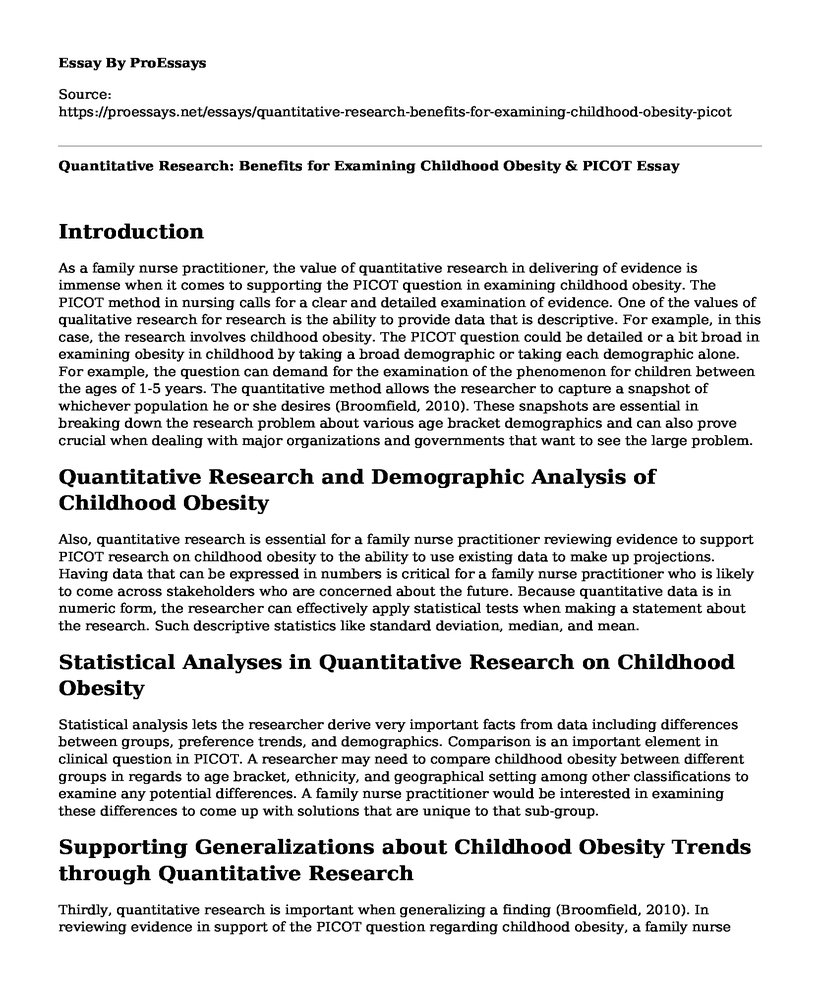Introduction
As a family nurse practitioner, the value of quantitative research in delivering of evidence is immense when it comes to supporting the PICOT question in examining childhood obesity. The PICOT method in nursing calls for a clear and detailed examination of evidence. One of the values of qualitative research for research is the ability to provide data that is descriptive. For example, in this case, the research involves childhood obesity. The PICOT question could be detailed or a bit broad in examining obesity in childhood by taking a broad demographic or taking each demographic alone. For example, the question can demand for the examination of the phenomenon for children between the ages of 1-5 years. The quantitative method allows the researcher to capture a snapshot of whichever population he or she desires (Broomfield, 2010). These snapshots are essential in breaking down the research problem about various age bracket demographics and can also prove crucial when dealing with major organizations and governments that want to see the large problem.
Quantitative Research and Demographic Analysis of Childhood Obesity
Also, quantitative research is essential for a family nurse practitioner reviewing evidence to support PICOT research on childhood obesity to the ability to use existing data to make up projections. Having data that can be expressed in numbers is critical for a family nurse practitioner who is likely to come across stakeholders who are concerned about the future. Because quantitative data is in numeric form, the researcher can effectively apply statistical tests when making a statement about the research. Such descriptive statistics like standard deviation, median, and mean.
Statistical Analyses in Quantitative Research on Childhood Obesity
Statistical analysis lets the researcher derive very important facts from data including differences between groups, preference trends, and demographics. Comparison is an important element in clinical question in PICOT. A researcher may need to compare childhood obesity between different groups in regards to age bracket, ethnicity, and geographical setting among other classifications to examine any potential differences. A family nurse practitioner would be interested in examining these differences to come up with solutions that are unique to that sub-group.
Supporting Generalizations about Childhood Obesity Trends through Quantitative Research
Thirdly, quantitative research is important when generalizing a finding (Broomfield, 2010). In reviewing evidence in support of the PICOT question regarding childhood obesity, a family nurse practitioner would need to generalize findings to see the large problem. Using statistics to work of the existing evidence, the nurse can use the trend indicated by the evidence to arrive at a generalized statement. For example, using the evidence available, the nurse can make the statement that childhood obesity among African-Americans will become a national disaster by 2050. This generalization can only be achieved if the researcher can use existing evidence to project into 2050 using statistics.
Conclusion
Lastly, quantitative research is essential for a family nurse practitioner when reviewing evidence because it often reduces a complex problem into easily understandable bits. In a PICOT question, the outcome of the research question is very essential to the research. In this case, the outcome of the research could be to reveal the economic cost of childhood obesity. The quantitative research can reduce the complexity of this research by offering the answer in simple units by using the evidence available. For example, the data may indicate that the Spanish community is suffering more economic cost of childhood obesity than the Caucasian community. Such outcome is simple to understand and present to stakeholders.
Reference
Broomfield, R. I. (2010). A nurses' guide to Quantitative Research. Australian Journal of Advanced Nursing, 32(2), 32-38. Retrieved from https://pdfs.semanticscholar.org/f86e/75e46108d8a8d596a08336e20fd151f7eb9d.pdf
Cite this page
Quantitative Research: Benefits for Examining Childhood Obesity & PICOT. (2023, Mar 27). Retrieved from https://proessays.net/essays/quantitative-research-benefits-for-examining-childhood-obesity-picot
If you are the original author of this essay and no longer wish to have it published on the ProEssays website, please click below to request its removal:
- Are Parents to Blame for Childhood Obesity Essay Example
- Essay Example on Venezuela: A Struggling Nation of Poverty and Culture Shock
- Essay Sample on Women Migrants in US: Exploring Inequality in Agricultural Employment
- Persons Living With HIV Face Discrimination in Healthcare: Barriers to Access - Essay Sample
- Asian Americans: Representation in U.S. Media and Its Impact - Essay Sample
- Essay Sample on Childish Gambino's This is America: A Commentary on American Society
- Mumbai Terror Attack: A Case Study of Terrorism - Paper Sample







